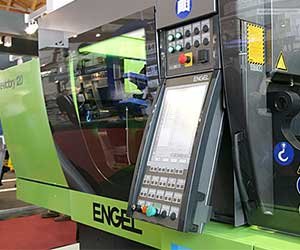 |
 |
E-News Update February 2011 |
LEAD FEATURE |
COMPANY NEWS |
MATERIALS NEWS |
MACHINERY NEWS |
EXHIBITION NEWS |
RUBBER JOURNAL ASIA |
INJECTION MOULDING ASIA |
![]() Injection Moulding Asia
Injection Moulding Asia
Hot gas welding integrated in injection moulding process
 |
The patent pending Joinmelt process uses a single mould for both halves of the component. Injection moulding is followed by the welding process without needing to take off the two halves of the part as an intermediate step. After cooling, the mould is opened; one half of the part stays in the left half and the other in the right half of the mould. The moveable left half of the mould is now positioned so that both parts are opposite each other in welding position. The heating element is positioned between the cavities. When the edges of the component halves are at welding temperature, the heater is withdrawn. When the mould closes, the two parts are bonded so that the finished part can be taken off when the mould re-opens.
Engel says the process is especially promising for the automotive components industry as it allows for considerable savings by removing the need for additional welding equipment. Plus, part take-off and re-insertion are no longer needed as the finished product can be taken off directly out of the mould. Apart from that the company says the control of welding quality is improved while retention of the product halves in the mould during the welding process avoids issues of warpage during the joining process.
The process also creates a clean and thin weld that is said to be particularly strong and achieves better quality with higher bursting pressure than welds created by traditional techniques. Furthermore, the thinner weld line reduces the volume of resin used.
The new technology is suitable for all thermoplastics including the glass fibre-reinforced nylon grades commonly used as media-bearing parts in engine compartments. Previously, these components had a visible bulge at the joint, making them prone to friction and reducing the service life of other functional parts, such as the valve tappets.
As the process avoids the bulge, the process additionally saves material and weight. Another benefit becomes apparent as early as the development phase of new products, says the company. Since there is no need to take a specific welding direction into account, this allows for freedom of choice with respect to part geometry.
The Joinmelt process makes use of Austria-based Hummel-Formen's in-mould hot gas welding technology and Germany-based KVT-Bielefeld's protective atmosphere plastics welding techniques.